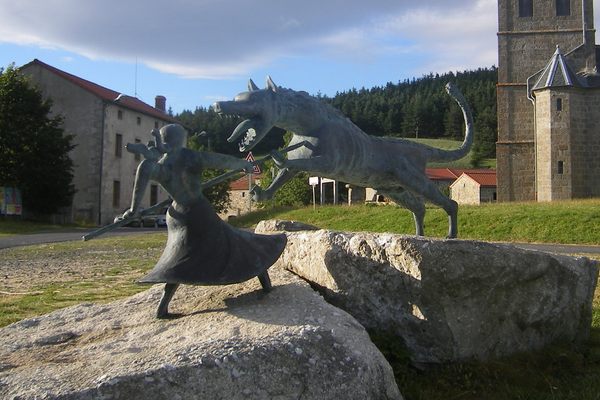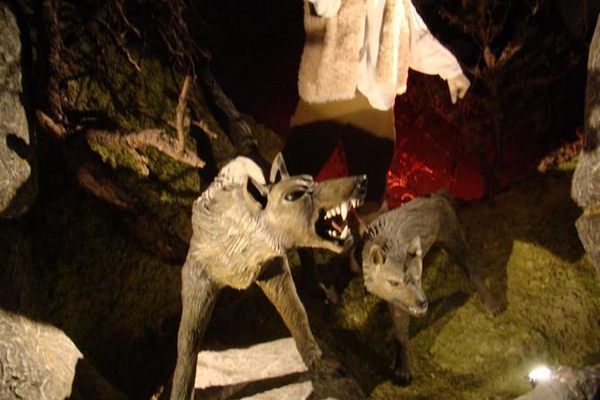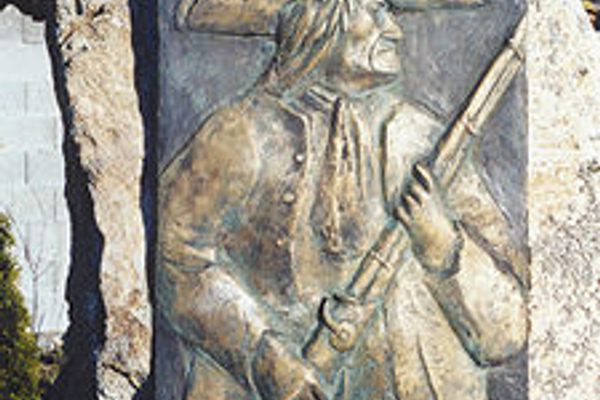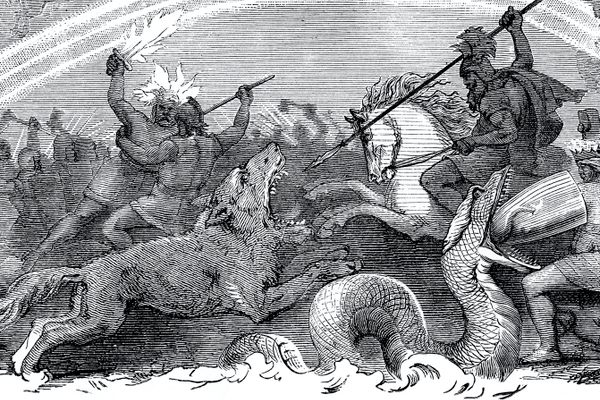Of Wolves and Men and Delicious Little Girls
31 Days of Halloween: On Atlas Obscura this month, we’re celebrating Halloween each day with woeful, wondrous, and wickedly macabre tales all linked to a real locale that you can visit, if you dare.
“Little Red Riding Hood & the Wolf,” by Gustave Doré (via Wikimedia)
At dusk, a young girl is snatched from the edge of a field, never to be seen again. Dawn brings the discovery of partially devoured bodies, and enormous footprints leading into the forest.
Considering some of the historic stories of deadly encounters with wolves, fanciful stories on the edges of truth of battles done with enormous wolf beasts, murderous men transformed into deadly Canis lupis through demonic bargains, and the power of the full moon, it is no wonder that even in the near absence of wolves in the modern wild, we still maintain an instinctual fear of the Big Bad Wolf.
Occasionally, the nightmare beast with glowing eyes, bloodstained claws, and mighty jaws dripping with gore turned out to be real.
Wherever they once roamed, wolves have given form to the fear of that which lurks at the edge of the light, hiding in the shadows and creeping along on silent paws. In children’s story and ancient fable, the wolf is an allegory for the devil or represents the fears of the unknown darknesses found when one strays from the safety of home.
Today, with wolves reduced to rarities, all but vanished in the wild except in the most remote parts of the world, it can be difficult to understand the true fear they instilled in the hearts of men, and the effect that living in the presence of a skilled predator had on the lives of people, even in cities and towns that could theoretically protect themselves.
Stories of rogue wolf packs attacking cities were not uncommon, including the time in 1450, when a pack of wolves breached the city walls, descended on the city of Paris, and killed and ate forty people.
By the next century, wolves, and people in the guise of wolves, were at the center of the witchcraft trials which spread across France and the rest of Europe. Shapeshifting was a common accusation, usually into whatever animal was feared most locally, or had been recently seen attacking livestock or people.
Detail, showing the death of Peter Stubbe (or Stumpp) (via University of Pittsburgh)
A sensational trial in Germany in 1589 saw a man accused of making a deal with the devil, shapeshifting into a wolf, and killing 128 people, among other assorted gruesome crimes.
Known as the “Werewolf of Bedburg,” Peter Stubbe (or Stumpp) was executed on October 31, 1589, along with his daughter and mistress. As an example to others tempted by the devil’s offer of magical shape shifting garments, the execution was spectacularly horrific. The story was spread throughout Europe in a pamphlet describing the trial, torture, and death with relish. Then, as now, a story with a title like A True Discourse. Declaring the Damnable Life and Death of One Stubbe Peeter, a Most Wicked Sorcerer sold like hotcakes, and the werewolf myth gained more ground in the popular mind.
“A True Discourse. Declaring the Damnable Life and Death of One Stubbe Peeter, a Most Wicked Sorcerer,” London, 1590 (via University of Pittsburgh)
After lurid accounts of his supposed crimes including assorted murders, acts of cannibalism, and the ripping of children from the wombs of their mothers, after which he “eate their hartes panting hotte and rawe,” his final execution was described thus:
....his body laide on a wheele, and with red hotte burning pincers in ten seue∣ral places to haue the flesh puld off from the bones, after that, his legges and Armes to be broken with a woodden Are or Hatchet, afterward to haue his head strook from his body, then to haue his carkasse burnde to Ashes.
Today there is debate over whether Stubbe was a spectacularly bad man — a serial killer of the day — or if perhaps the spate of deaths might in fact be blamed on actual, non-demonic, non-shifting wolves, or whether he simply found himself, like so many others, on the wrong side of an inquisitor’s political or religious agenda.
Whatever the truth, his was not an isolated case by any stretch of the imagination: in France alone, between 1598 and 1600, it has been reported that more than 600 people were sentenced to death on accusations of shapeshifting into wolves.
Sometimes, wolves were fearsome enough without demonic intervention.
In the late 18th century, something had gone very wrong in the relationship between people and wolves in France: In 1765, a wolf attacked 18 people, killing four in Soissons. A pack of wolves in Perigard attacked in 1766, killing 18 people. Four of the wolves were eventually killed, and two are on display as taxidermy mounts at the chateau of Razac. Another wolf in the town of Sarlat attacked 17 people that same year
18th century illustration of the Beast of Gévaudan (via Wikimedia)
Perfectly timed to take advantage of the crippling fear the French citizens had cultivated for wolves, a spectacularly fearsome creature entered the fray.
Described by witnesses and survivors as a massive red-black wolf-like creature, with enormous claws and crushing fangs, something started killing in the spring of 1674 in the countryside of the rural area of Gévaudan, starting with one young girl tending a flock of sheep, and eventually attacking more than a hundred people, mostly women and children, killing and devouring most of them. The locals dubbed it The Beast of Gévaudan.
In the face of such horror, the local citizenry understandably freaked out. They sent hunters by the thousands to sweep the woods and mountains where the beast was thought to roam. They killed dozens, probably hundreds, of wolves in the attempt to stop the violence.
In January of the following year a group of eight young boys were attacked and managed to survive to tell their tale, which reached all the way to Louis XV, who granted a reward to the youngsters and followed up by sending his finest huntsmen to the countryside to find and kill the beast. While these marksmen tracked the wolf without success, the attacks continued unabated. One young woman met the beast on the road, and nearly killed it.
Statue in Auvers of the attack (photograph by Szeder László)
According to sworn testimony recorded in 1765, a young woman named Marie-Jeanne Valet was walking through the wooded countryside, crossing between two branches of a river, when she turned and, to her horror, saw the beast tracking her from behind.
The beast attacked, and she parried, thrusting a homemade spear into the beast’s chest. Injured, the animal cried out in pain and lifted an enormous paw to the wound, before disappearing into the racing waters of the river.
The king’s men were fascinated by the story, calling her “the Maid of Gévaudan,” and comparing her to Joan of Arc.
The attacks did not stop.
The next month, the king’s men caught word that a large wolf, with mate and whelps, had been spotted in nearby woods. They recruited forty sharpshooters, gathered the guns and the hunting dogs and headed into the woods. There they quickly found themselves face to face with an angry, protective, and six-foot-long, 140 pound wolf. The king’s gun bearer raised his musket and took aim. A shot to the eye only slowed the animal in his attack, and despite being hit a second time, the beast covered another 25 yards before succumbing to his wounds.
Illustration of the wolf shot in 1765 (via Wikimedia)
This massive wolf — known as Le Loup de Chazes — was triumphantly preserved and brought back and presented at the court of Louis XV. The huntsmen were fêted as victors over the dreaded beast.
The attacks continued.
The king’s hunters turned their attention to the female wolf and the youngsters, which had escaped the September battle in the woods. More large wolves were killed in the following months, and the attacks on villagers seemed to come to an end. The king’s men called it a day, collected their reward, packed their bags, and left Gévaudan.
A few months later, in the dead of winter, the attacks began anew.
It was not until June of 1767 that the end finally came, when a local farmer and innkeeper by the name of Jean Chastel headed to the hills in pursuit of the Beast. According to legend, when Chastel made his way to the beast’s lair, he sat down, and opened his Bible, and patiently waited for the animal to approach. As a huge wolf came out of hiding, unable to resist the opportunity, Chastel raised his gun and fired, killing the legendary Beast of Gévaudan at last.
1765 illustration of the beast (via The London Magazine)
There remain a lot of questions surrounding the basic facts reported at the time, and the passage of centuries has allowed the already extraordinary story to be embellished and an almost unceasing dialogue about just who or what caused the beast to attack, and what the true identity of the beast might have been. Later accounts put the story firmly in werewolf country, and claim Chastel took the beast down with a silver bullet, melted from a religious amulet, despite no contemporary sources claiming as much. Others have theorized that Chastel and his family may have in fact trained the attack animal for their own nefarious gain, while still others postulate that the animal was a rampaging hyena, rather than a wolf, or a cryptid of some other more fanciful sort. Most scholars of the subject agree that the most likely culprit was a series of attacks by several large — but not mythically so — wolves over time.
Today the area once known as Gévaudan (now Lozère), like most of Western Europe, is essentially wolf-free, people having long since hunted the animals to near extinction. Only in recent years have small wild populations started to reappear. However, the area has embraced its long association with the Beast, and is home to numerous memorials, monuments, and proud statues of the Beast and its hunters.
Perhaps most encouragingly, it is also home to Les Loups du Gévaudan park, a wolf sanctuary where over 100 wolves live in and roam the lands in which they once hunted, a place dedicated to their history and restoring their reputation in France.
Further Reading:
Jay Smith, Monsters of Gevaudan, 2011 Harvard University Press
Historic Werewolves - Mental_Floss
Charles Perrault’s original “Little Red Riding Hood” short story. Spoiler: it’s a happier ending for the wolf than Little Red.
Explore in the Footsteps of the Beast:
LES LOUPS DU GEVAUDAN WOLF SANCTUARY, Saint-Léger-de-Peyre, France
MONUMENT TO JEAN CHASTEL, La Besseyre-Saint-Mary, France
MARIE-JEANNE VALET VS. THE BEAST OF GEVAUDAN, Auvers, France
MUSEUM OF THE BEAST OF GEVAUDAN, Saugues, France
More Wolf Sanctuaries:
WOLF CONSERVATION CENTER, South Salem, New York
SEACREST WOLF PRESERVE, Chipley, Florida
Click here for more of our 31 Days of Halloween, where each day we’re celebrating the strange-but-true unsettling corners of the world.













Follow us on Twitter to get the latest on the world's hidden wonders.
Like us on Facebook to get the latest on the world's hidden wonders.
Follow us on Twitter Like us on Facebook